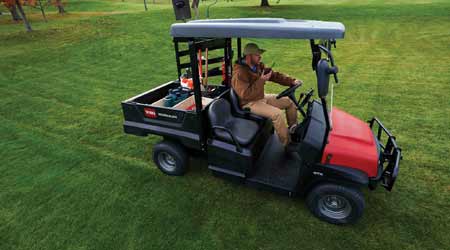 Beyond sustainability considerations related to emmissions, fuels and noise, managers purchasing new grounds equipment also need to select products that will deliver reliable, long-term performance.
Beyond sustainability considerations related to emmissions, fuels and noise, managers purchasing new grounds equipment also need to select products that will deliver reliable, long-term performance.Sustainability: Beyond Emissions, Fuel and Noise
Advances in technologies designed to protect the environment give managers more tools to achieve performance and bottom-line goals.
Going long (term)
Beyond emissions, fuel, and noise, managers focusing on sustainability in specifying mowers, utility vehicles, and powered hand tools need to select products that will deliver reliable, safe long-term performance without requiring replacement and, therefore, waste.
Performance considerations include fuel type, life-cycle considerations, application requirements, maintenance needs and, perhaps most importantly, cost.
“Engine fuel type, gas or diesel, and fuel-delivery method, — carbureted or electronic fuel injection (EFI) — are the two big things to pay attention to,” Minas says. “If cost is less of an issue, then a diesel engine tends to burn cleaner, assuming it’s a EPA Tier 4 engine, and more efficient. If gasoline is the preferred fuel, then an EFI engine will be more efficient and tend to be a bit cleaner than a carbureted engine.”
Managers also need to monitor the life-cycle costs of grounds equipment.
“For example, if a buyer purchases a piece of equipment for $6,000, they might think they have gotten a good deal,” Simmon says. “However, if the equipment costs them $2,000 in the first year due to downtime, malfunctions or lack of durability in the application, then no savings was realized in the original purchase.
“Also, what additional productivity can the equipment bring through accessories or implements to give value-added features? A mower that can not only mow but (that can) switch to an aeration implement or snow-clearing implement adds value in that the entity can get year-round use without buying several pieces of equipment with multiple engines to maintain to perform the same tasks.
“Value-added features are also related to transmissions, engines, ergonomics, and frame and deck construction. Many of these value-added features separate true commercial equipment from flashy marketing gimmicks because these features extend past the price.”
Related Topics:














